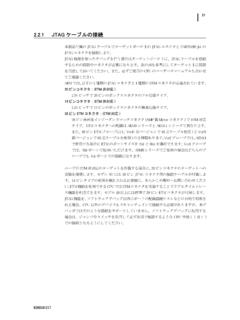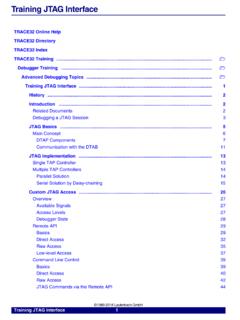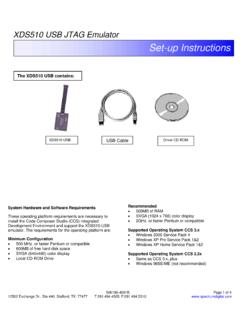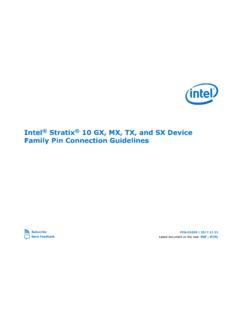Transcription of IEEE standard test access port and boundary-scan ...
1 The Institute of Electrical and Electronics Engineers, Park Avenue, New York, NY 10016-5997, USAC opyright 2001 by the Institute of Electrical and Electronics Engineers, rights reserved. Published 23 July 2001. Printed in the United States of : ISBN 0-7381-2944-5 SH94949 PDF: ISBN 0-7381-2945-3 SS94949No part of this publication may be reproduced in any form, in an electronic retrieval system or otherwise, without the prior written permission of the Std (Revision of IEEE Std )IEEE standard Test access Port and boundary-scan ArchitectureSponsorTest Technology Standards Committeeof theIEEE Computer SocietyApproved 14 June 2001 IEEE-SA Standards BoardAbstract.
2 Circuitry that may be built into an integrated circuit to assist in the test, maintenance, andsupport of assembled printed circuit boards is defined. The circuitry includes a standard interfacethrough which instructions and test data are communicated. A set of test features is defined,including a boundary-scan register, such that the component is able to respond to a minimum setof instructions designed to assist with testing of assembled printed circuit boards. Also, a languageis defined that allows rigorous description of the component-specific aspects of such : boundary scan, boundary-scan architecture, boundary-scan Description Language, boundary-scan register, BSDL, circuit boards, circuitry, integrated circuit, printed circuit boards,TAP, test, test access port, VHDL, VHSIC Hardware Description LanguageIEEE Standards documents are developed within the IEEE Societies and the Standards Coordinating Committees of theIEEE Standards Association (IEEE-SA) Standards Board.
3 The IEEE develops its standards through a consensus develop-ment process, approved by the American National Standards Institute, which brings together volunteers representing variedviewpoints and interests to achieve the final product. Volunteers are not necessarily members of the Institute and serve with-out compensation. While the IEEE administers the process and establishes rules to promote fairness in the consensus devel-opment process, the IEEE does not independently evaluate, test, or verify the accuracy of any of the information containedin its of an IEEE standard is wholly voluntary. The IEEE disclaims liability for any personal injury, property or other dam-age, of any nature whatsoever, whether special, indirect, consequential, or compensatory, directly or indirectly resultingfrom the publication, use of, or reliance upon this, or any other IEEE standard IEEE does not warrant or represent the accuracy or content of the material contained herein, and expressly disclaimsany express or implied warranty, including any implied warranty of merchantability or fitness for a specific purpose, or thatthe use of the material contained herein is free from patent infringement.
4 IEEE Standards documents are supplied AS IS. The existence of an IEEE standard does not imply that there are no other ways to produce, test, measure, purchase, market,or provide other goods and services related to the scope of the IEEE standard . Furthermore, the viewpoint expressed at thetime a standard is approved and issued is subject to change brought about through developments in the state of the art andcomments received from users of the standard . Every IEEE standard is subjected to review at least every five years for revi-sion or reaffirmation. When a document is more than five years old and has not been reaffirmed, it is reasonable to concludethat its contents, although still of some value, do not wholly reflect the present state of the art.
5 Users are cautioned to checkto determine that they have the latest edition of any IEEE publishing and making this document available, the IEEE is not suggesting or rendering professional or other servicesfor, or on behalf of, any person or entity. Nor is the IEEE undertaking to perform any duty owed by any other person orentity to another. Any person utilizing this, and any other IEEE Standards document, should rely upon the advice of a com-petent professional in determining the exercise of reasonable care in any given : Occasionally questions may arise regarding the meaning of portions of standards as they relate to specificapplications.
6 When the need for interpretations is brought to the attention of IEEE, the Institute will initiate action to prepareappropriate responses. Since IEEE Standards represent a consensus of concerned interests, it is important to ensure that anyinterpretation has also received the concurrence of a balance of interests. For this reason, IEEE and the members of its soci-eties and Standards Coordinating Committees are not able to provide an instant response to interpretation requests except inthose cases where the matter has previously received formal consideration. Comments for revision of IEEE Standards are welcome from any interested party, regardless of membership affiliation withIEEE.
7 Suggestions for changes in documents should be in the form of a proposed change of text, together with appropriatesupporting comments. Comments on standards and requests for interpretations should be addressed to:Secretary, IEEE-SA Standards Board445 Hoes Box 1331 Piscataway, NJ 08855-1331 USAIEEE is the sole entity that may authorize the use of certification marks, trademarks, or other designations to indicate com-pliance with the materials set forth to photocopy portions of any individual standard for internal or personal use is granted by the Institute ofElectrical and Electronics Engineers, Inc.
8 , provided that the appropriate fee is paid to Copyright Clearance Center. Toarrange for payment of licensing fee, please contact Copyright Clearance Center, Customer Service, 222 Rosewood Drive,Danvers, MA 01923 USA; (978) 750-8400. Permission to photocopy portions of any individual standard for educationalclassroom use can also be obtained through the Copyright Clearance : Attention is called to the possibility that implementation of this standard may require use of subject mat-ter covered by patent rights. By publication of this standard , no position is taken with respect to the existence orvalidity of any patent rights in connection therewith.
9 The IEEE shall not be responsible for identifying patentsfor which a license may be required by an IEEE standard or for conducting inquiries into the legal validity orscope of those patents that are brought to its 2001 IEEE. All rights (This introduction is not part of IEEE Std , standard Test access Port and boundary-scan Architecture.)This standard defines a test access port and boundary-scan architecture for digital integrated circuits and forthe digital portions of mixed analog/digital integrated circuits. The facilities defined by the standard seek toprovide a solution to the problem of testing assembled printed circuit boards and other products based onhighly complex digital integrated circuits and high-density surface-mounting assembly techniques.
10 Theyalso provide a means of accessing and controlling design-for-test features built into the digital integrated cir-cuits themselves. Such features might, for example, include internal scan paths and self-test functions aswell as other features intended to support service applications in the assembled of the development of this standardThe process of developing this standard began in 1985, when the Joint European Test Action Group(JETAG) was formed in Europe. During 1986, this group expanded to include members from both Europeand North America and, as a result, was renamed the Joint Test Action Group (JTAG).






